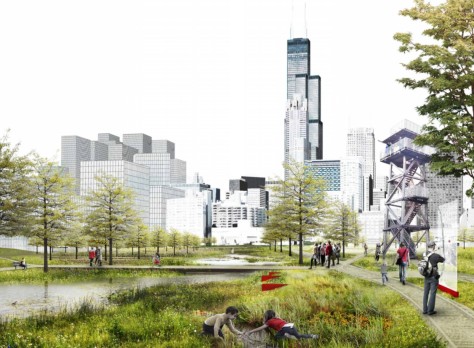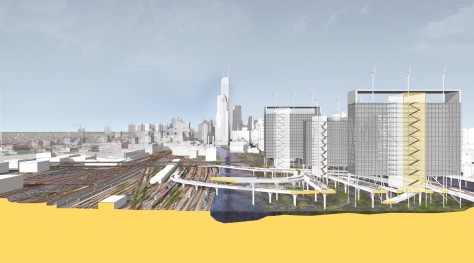The 200+ acres of land, just south of Chicago’s urban core, is one of the largest remaining areas that is looking for a creative solution to vitalize this otherwise underutilized opportunity. Over the last 75 years or so, this area in particular, on the river adjacent to Chicago’s Loop, has been slow to develop, remaining mostly infrastructure or vacant. There was no set program for the competition this year. One of the primary design problems was to develop a master plan or overall site strategy (Part I) and choose one element of the master plan and develop in detail (Part II).
First prize: Grid | River | Landmark – Silas Haslam, Yanwen Xiao, Washington, D.C. office

“The Chicago River is a critical component in identifying the sense of place of the competition site. The river’s path has consistently been modified to accommodate urban development, while the flow direction has been changed to push pollutants to the south.

However, we propose to redevelop this area with a long standing goal: purify the Chicago River.

This area will not be further developed without improving the river’s water quality and direct interaction with the water will never become a reality until real, large-scale decontamination efforts are instituted. Using the old river paths as a datum, we developed a wetland and a landmark building as a system to purify the water.”
Second Prize: South Branch Succession – Chris Loyal, Lauren Fraley, Atlanta office

“Our project seeks to reconnect a fragmented urban landscape, instill memory in Chicago’s new urban “tell”, and anticipate resiliency in order to set the framework for future succession. Through the interplay between high and low, ascending and descending, different elements of the site and the larger urban context are revealed, providing a unique perspective of the city and site.

Exposing the active rail lines below the development allows people to witness industrial forces that have fueled the growth of Chicago, while also activating the site from below. Creating a wetlands park that follows the old path of the river allows the visitor to understand the sheer amount of effort that went into making the city what it is today.

A build-up of density and verticality closer to the Central Business District provides amazing views from the north end of the site, allowing one to experience it in one glance from a tower’s-eye level. These design elements address many aspects of the site’s rich history, and look to the future with proposed parks and buildings. It is the revelation of historical elements and the future activation of a very important site in Chicago that help this project tell the story of succession.”
Third Prize: SWITCHRAIL – Scott Hefner, Ian Zapata, William Sendor, Research Triangle Park and Charlotte offices

“In the case study, the site just south of the Loop, an existing rail yard, is repurposed as a massive transformable park in which rail cars outfitted with trees, benches, band shells, restaurants, kayak rentals, all move along the network of rails. This dynamic view of park space brings patrons what they need at any given time – the program of the park will change from day to day and season to season.

On the east side of the riverbank, a wetland helps filter water from one of the most polluted rivers in the country. Over this elaborate natural system is a network of new weaving tracks and mixed use development. The tracks connect all of the buildings and act as a dynamic pedestrian interface at the street level.

The Switchrail network in Chicago will transform the way the city views unused rail lines: now as an opportunity for a small pocket park or an opportunity to connect neighborhoods.” Source by Perkins + Will.

